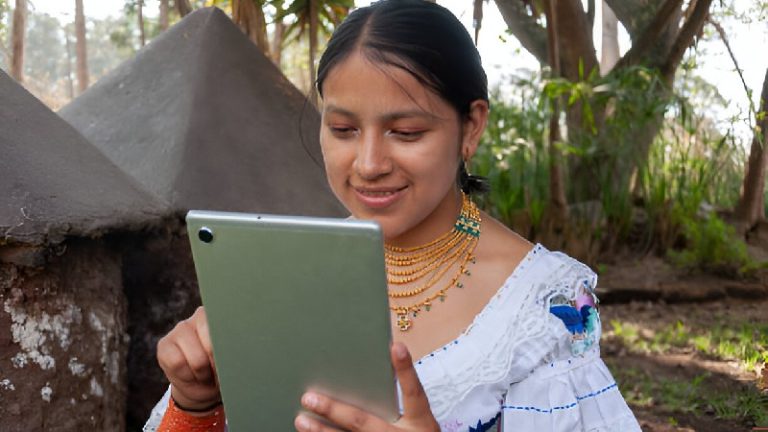Bridging the digital divide is widely acknowledged, the educational sector often focuses solely on providing devices and internet access. However, a more fundamental shift is required: creating personalized educational pathways that leverage digital tools to address the unique learning needs and socio-economic realities of underserved communities.
This article explores how we can move beyond simply providing technology to designing adaptive, culturally relevant educational experiences that truly empower learners and, in turn, effectively contribute to bridging the digital divide.
The importance of integrating digital literacy into core curricula, ensuring that learners not only access technology but understand how to use it effectively. By integrating real-world examples and expert insights, we will demonstrate how a holistic approach, focused on personalized education, can be a transformative tool for bridging the digital divide.
Personalized Educational Pathways for Bridging the Digital Divide
The traditional “one-size-fits-all” educational model often fails to meet the diverse needs of learners, particularly those from marginalized communities. To truly bridge the digital divide in education, we must embrace personalized learning pathways. This involves leveraging digital tools to create adaptive learning experiences that cater to individual learning styles, paces, and socio-economic contexts.
Adaptive learning software, for instance, can adjust the difficulty and content of lessons based on a learner’s progress. AI-driven educational platforms can provide personalized feedback and recommendations, identifying areas where learners need additional support. Furthermore, community-based mentorship programs can pair learners with local experts who can provide guidance and support, bridging the gap between formal education and real-world application.
Customizing Education for Diverse Learning Needs in Bridging the Digital Divide
Adaptive technology plays a crucial role in creating personalized learning pathways. By analyzing learner data and adjusting content in real-time, these tools ensure that each learner receives the support they need to succeed. For example, a student struggling with math concepts might receive additional practice problems and targeted explanations, while a student excelling in the subject might be presented with more challenging material.
This approach not only enhances learning outcomes but also increases engagement and motivation. By tailoring educational experiences to individual needs, we can make learning more relevant and accessible, thereby contributing to bridging the digital divide in a meaningful way.
Connecting Learners with Local Expertise for Bridging the Digital Divide
Beyond adaptive technology, community mentorship programs can provide invaluable support to learners from underserved communities. Local experts, such as entrepreneurs, artists, and scientists, can share their knowledge and experience, inspiring learners and providing real-world context for their education.
These programs can also help learners develop essential soft skills, such as communication, collaboration, and problem-solving. By connecting learners with local role models, we can empower them to pursue their passions and contribute to their communities, playing a vital role in bridging the digital divide in a sustainable manner.
Empowering Learners Beyond Access for Bridging the Digital Divide

Providing devices and internet access is only the first step. To truly empower learners, we must integrate digital literacy into core curricula. This involves teaching students how to use digital tools effectively, critically evaluate online information, and navigate the digital world safely and responsibly.
Digital literacy goes beyond basic computer skills. It encompasses understanding online privacy, recognizing misinformation, and using digital tools for creative expression and problem-solving. By embedding digital literacy into the curriculum, we can ensure that learners not only access technology but understand how to leverage it for learning, work, and civic engagement, becoming a key component of bridging the digital divide.
Shifting Personalized Educational Pathways for Bridging the Digital Divide
| Traditional Approach (Device-Focused) | Holistic Approach (Personalized Pathways) | Impact on Bridging the Digital Divide |
| Providing laptops and internet access | Creating adaptive learning software and AI-driven platforms | Tailors education to individual needs, enhancing engagement |
| Generic digital literacy workshops | Integrating digital literacy into core curriculum | Ensures sustainable digital skills and responsible usage |
| Limited community involvement | Community-based mentorship programs connecting learners with local experts | Provides real-world context and role models |
| Focus on infrastructure alone | Emphasizing learner-centric content and support | Creates lasting educational impact and empowerment |
Personalized Education In Action for Bridging the Digital Divide
Several initiatives are demonstrating the power of personalized learning pathways. For example, the Khan Academy provides free, personalized learning resources to millions of learners worldwide, using adaptive technology to tailor lessons to individual needs. Similarly, the African Leadership University (ALU) employs personalized learning models, leveraging technology and community engagement to empower African students.
These examples highlight the transformative potential of personalized education in bridging the digital divide. By focusing on creating tailored learning experiences, we can empower learners from all backgrounds to reach their full potential.
Statistics and Expert Insights:
According to a UNESCO report, “Personalized learning can improve learning outcomes by up to 20%.” Experts emphasize that personalized learning pathways, coupled with digital literacy, are crucial for creating equitable educational opportunities. The World Economic Forum highlights the importance of integrating digital skills into education to prepare learners for the future workforce.
Conclusion
Bridging the digital divide in education requires a shift from simply providing devices to creating personalized learning pathways. By leveraging adaptive technology, integrating digital literacy into core curricula, and fostering community-based mentorship, we can empower learners from all backgrounds to thrive in the digital age. This holistic approach, focused on personalized education, is essential for creating a more equitable and inclusive future.
FAQs
Q: What is the main focus of this article regarding bridging the digital divide?
A: The article focuses on shifting from simply providing devices and internet access to creating personalized educational pathways that leverage digital tools to address the unique learning needs of underserved communities.
Q: How does personalized learning contribute to bridging the digital divide?
A: Personalized learning uses adaptive software, AI-driven education, and community mentorship to create tailored learning experiences, making education more accessible and effective for diverse learners.
Q: What is adaptive technology and how does it help in education?
A: Adaptive technology adjusts the difficulty and content of lessons based on a learner’s progress, ensuring each learner receives the support they need to succeed.
Q: Why is community mentorship important in bridging the digital divide in education?
A: Community mentorship connects learners with local experts who can provide guidance and real-world context for their education, fostering engagement and inspiration.
Q: What does digital literacy encompass in the context of this article?
A: Digital literacy goes beyond basic computer skills, including understanding online privacy, recognizing misinformation, and using digital tools for creative expression and problem-solving.
Q: How can integrating digital literacy into core curricula help bridge the digital divide?
A: By teaching students how to use digital tools effectively and responsibly, it ensures they can leverage technology for learning, work, and civic engagement, empowering them beyond mere access.
Q: What are some real-world examples of personalized education initiatives?
A: Examples include the Khan Academy, which provides personalized learning resources, and the African Leadership University (ALU), which employs personalized learning models.
Q: What are the key elements of a holistic approach to bridging the digital divide in education?
A: Key elements include creating adaptive learning software, integrating digital literacy into curricula, and fostering community-based mentorship.
Q: How does this approach differ from traditional methods of addressing the digital divide in education?
A: Traditional methods often focus on providing devices and internet access, while this approach emphasizes creating personalized learning experiences and empowering learners with digital literacy.
Q: What is the potential impact of personalized educational pathways on underserved communities?
A: It can empower learners to reach their full potential, create equitable educational opportunities, and prepare them for the digital workforce.


